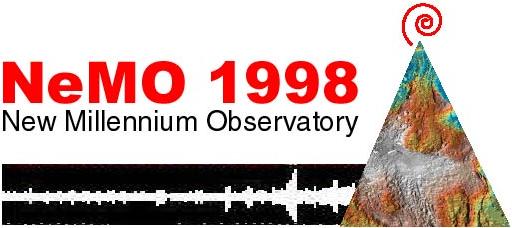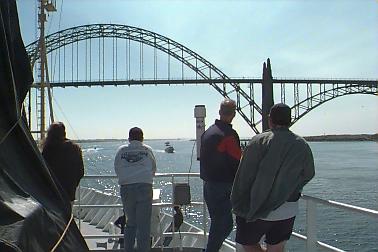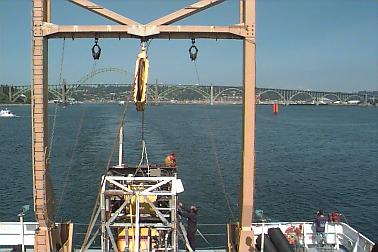WHAT'S NEW:
Other 1998 Axial Cruise Reports
(posted 8/13/98)
BACKGROUND:
Technology (ROV, ships, etc.)
Other 1998 Axial cruise reports
EXPEDITION:
Science Objectives
Calendar
Today's Science News
Participant Perspective
Teacher Logbook
EDUCATION:
Curriculum
Teacher Observations
Questions/Answers from sea
MULTIMEDIA:
(video clips, animations, sounds)

Logbook
August 25, 1998
August 25, 1998
Contents: |

Scientists aboard NOAA ship Ron Brown heading for open sea under the Yaquina Bay Bridge, Newport, Oregon (photo: J. Gendron/NOAA) |
Science Report

Departure was delayed until 1500PST due to problems with interfacing scientific instruments with the ROV. Engineers worked up to departure time to resolve difficulties, not all repaired but work will continue while underway to study site. Transit time to site is estimated at ~20 hours.
Engineers working on ROV ROPOS as it sets sail for the NeMO 1998 cruise to Axial Volcano (photo: J.Gendron/NOAA)
Listing of all Science News postings
Life at Sea: Participant Perspective
Susan Merle
August 25th, 2200
We are steaming towards Axial Volcano and hope to be on site by tomorrow afternoon. Most of the mechanical problems we were experiencing earlier have been resolved. The Imagenex survey system is now operating as it should be. The low-light digital camera cannot be used in real-time mode for the moment, but the data will be collected and referred to later. We are hoping for a fix for the camera before long. Relaying all the data up the cable from the ROPOS to the lab computers is a big challenge. It looks like the ROPOS team has ironed out most of the problems. We're all ready to begin working, tomorrow morning that is. At present most of the science crew are in their racks getting as much rest as they can while we are in transit. Tomorrow when we arrive on site the first order of operations will be to deploy the transponders we will be using to assist in navigating the ROV.
-Susan Merle
Listing of all Perspectives postings
Teacher At Sea Logbook
I remember in one of the first films I ever saw about ridges and vents, Dr. Robert Ballard was nervously pacing the deck while repairs to his ship kept him in port when he needed to be at sea scouting up the location of the vents to which the DSV Alvin would be diving a short time later. Apparently such delays are not uncommon in the ocean realm. We are still tied to the pier in Newport, Oregon, now scheduled for a departure at 1500 this afternoon. Vital pieces of research gear are still refusing to talk to each other, and without them we cannot hope to accomplish the goals set forth for this voyage. Chief scientist, Dr. Robert Embley is looking increasingly harried, but he has gathered a fine group of investigators for the trip and everyone is confident that the problems will be resolved by this afternoon. All scientists hate to lose scheduled ship time at sea, but in this era of shrinking resources and the consequent tight scheduling of available ship time, time lost at sea will undoubtedly be impossible to regain. Nowhere is this more true than in the use of large ships like the Brown that are capable of supporting the kind of deep-sea research that is planned for this voyage. One of the scientists on board told me that this ship costs $30,000 per day, even when it is sitting at the dock. No wonder folks are getting nervous.
Briefly, as it was explained to me by one of the developers of the Canadian ROPOS system, there are only six ports on the ROPOS to electronically connect to the instruments it carries. High resolution video recording that would be acceptable for broadcast requires two ports, and the SONAR imaging system also requires two ports. This only leaves two ports for other equipment. There will have to be some compromises made in order to get the most out of each dive. No scientist wants to miss the chance to put his or her instruments on the bottom at the dive site. Perhaps a lower quality of video that will free up an extra port is one option.
Another problem that has arisen is that some of the new equipment that is to be mounted to the ROPOS does not fit into the space allotted and so other devices will have to be removed to accommodate the new equipment. This will slow the process each and every time the ROPOS comes onto the deck to be outfitted for the next dive. The science team is working on plans to streamline the process and put the dives into a sequence that will allow for a maximum utilization of time at sea.
1530 hours and we are standing out to sea. Newport is disappearing behind us and a whole lot of saltwater lies ahead. The weather is fair and the sea nearly flat calm.. We expect to arrive on station some time early tomorrow. Bookmark us now and come on back every day from now through September 20 when we next see and walk on solid land. We'll see and learn a lot between here and there.
Logbook of all Teacher At Sea postings
Question/Answer of the Day
Send Your Question to NeMO
Back to Calendar